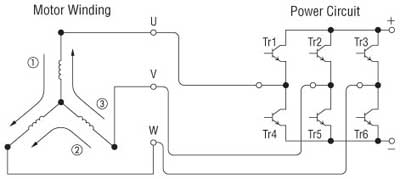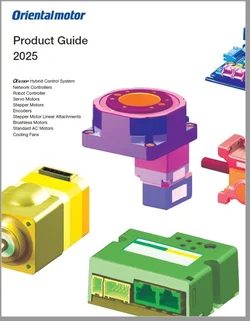While AC induction motors and VFDs are often the go-to choice for speed control applications, several other alternatives are available, from servo motors to AC motors with tachometers. However, brushless (BLDC) motor technology is quickly growing in popularity in compact designs while also offering other advantages that are often overlooked.
Background of Speed Control
When it comes to variable speed control applications, here are the options available in the market:
- AC induction motor with VFD
- AC induction motor with tachometer and voltage controller
- Brushed DC motors with voltage controller
- Brushless motors with driver
- Servo motor and driver
Any of these options would perform speed control, albeit with different methods. The question is, which one is the best for the application? If you ask most design engineers, the traditional choice is using an AC induction motor with a VFD because it's a one-size-fits-all solution. However, brushless motors have been gaining popularity.
In this article, I will discuss the main differences between using an AC motor with a VFD versus a brushless motor with its dedicated driver and explain why brushless motors should also be considered for variable speed control applications.
How Does a VFD (Inverter) Work?

A VFD, or inverter, converts fixed-voltage, fixed-frequency AC power to variable-voltage, variable-frequency AC power. It's an open-loop type controller that changes the speed of a three-phase AC induction motor by varying the frequency and voltage supplied to the motor.
A VFD, or inverter, first converts the input AC power to DC using a rectifier. Capacitors smooth out the rectified DC power, and then this DC power is "inverted" back to AC at the user's desired frequency by rapidly switching the DC bus on and off (AKA PWM - pulse width modulation). This is why VFDs are sometimes called "inverters".
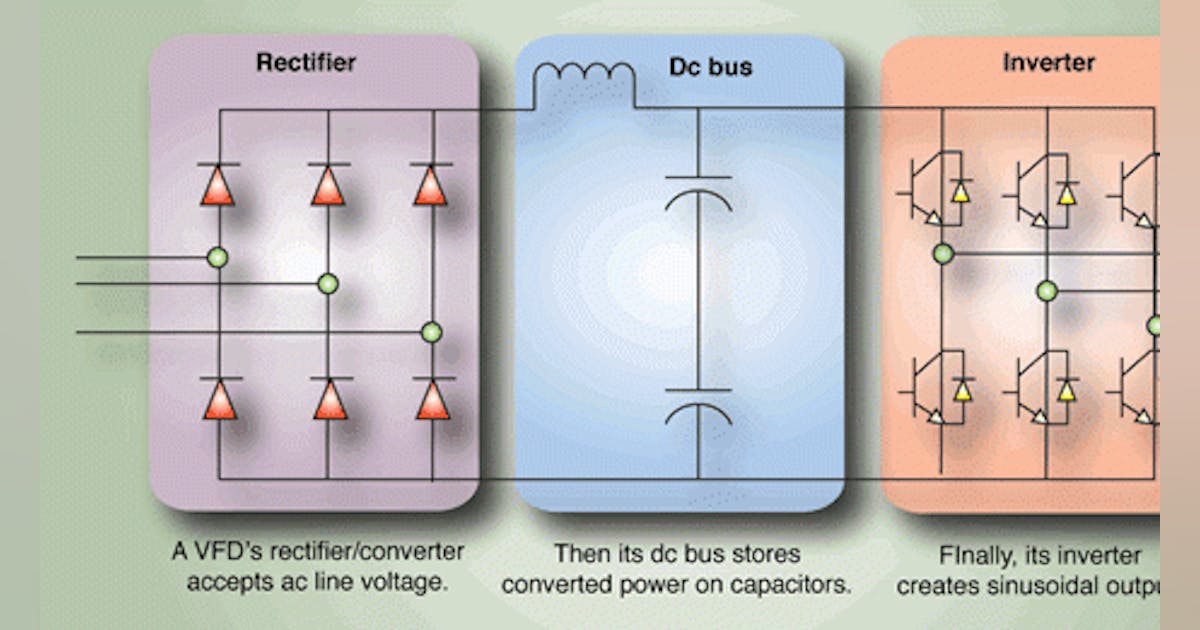
Source: Machine Design
As the frequency changes, the inverter, or VFD, also adjusts the voltage proportionally to maintain a constant voltage-to-frequency ratio, ensuring a more consistent torque output.
The speed of an AC induction motor is directly related to the number of poles (typically 2, 4, 6, or 8) and the frequency (Hz) of the AC power.
The formula to calculate the speed of an AC induction motor from the power frequency is:
N = (120 * f) / p
Where:
N = Synchronous speed of the motor in RPM
f = Frequency of the power supply in Hz
p = Number of poles in the motor
For example, for a 4-pole motor running on 60 Hz power:
N = (120 * 60) / 4 = 1800 RPM
Keep in mind that this formula calculates the synchronous speed, which is the theoretical rotational speed of the magnetic field generated inside the motor once power is supplied. The actual speed of the output shaft with rated load, AKA "rated speed", could be 1600~1700 RPM due to motor slip characteristics for AC induction motors. Increasing the load further will slow down the rated speed until the motor stalls.
It's worth noting that this formula is why 60 Hz power systems (standard in North America) and 50 Hz systems (common in many other parts of the world) result in different speeds for the same AC induction motor.
VFDs offer good speed regulation at -3 to -15%. Some can sense back EMF and offer better speed regulation. However, since they are not closed-loop systems, they do not offer great speed regulation, especially when the load varies, such as on a material handling conveyor.
How Does a Brushless Motor Driver work?

To generate rotation, a brushless motor uses closed-loop feedback and a driver to electronically commutate the motor windings in a specific sequence. Since brushless motors use permanent magnets in their rotors, there's no motor slip like AC induction motors, which makes them synchronous and more responsive.
Here's an example of a typical switching sequence of individual transistors that control the current flow to the motor windings.
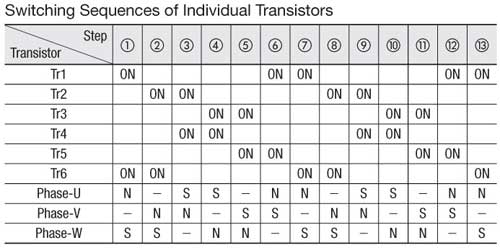
How does the driver know when to energize the stator winding coils? Good question. The driver uses hall-effector sensors, placed 120 degrees apart inside the motor, to detect the magnetic fields from magnetic poles on the rotor. The same information is also used to determine which phase to energize next to keep the motor rotating. By adjusting the speed at which it cycles through the commutation sequence, the driver can control the brushless motor's speed.
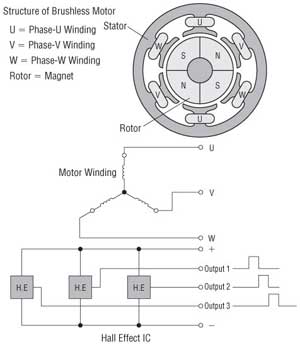 |
|
The advantage of having closed-loop feedback with hall-effect sensors is that the driver will always monitor the difference between set speed and actual speed and ensure speed regulation at around +/-0.2 to 0.5%. If the motor slips outside of that range, the driver will increase the motor's torque to maintain speed regulation. With encoder feedback, the speed regulation can be around +/-0.05%, even when the load varies.
Why Brushless Motors?
As we have learned so far, an inverter (VFD) changes the speed of a 3-phase AC induction motor by adjusting the power supply frequency. A brushless motor driver changes the phase excitation sequence speed to change the speed of a brushless motor. On the outside, a VFD and a brushless motor driver are very similar in their control, functions, and I/O, but a brushless motor driver is typically packed with dedicated functions and is smaller in size.
Costwise, brushless motor drivers have higher initial costs but are pretty close in low to medium power ratings, but VFDs tend to be less expensive in high power ranges. Brushless motor drivers require more complex control algorithms and electronics due to closed-loop feedback, while VFDs have simpler control schemes, especially for basic types.
While closed-loop feedback and speed regulation are the primary advantages on the control side, on the motor side, brushless motors also offer these advantages over AC induction motors due to their design, structure, and characteristics, such as smaller size, less heat generation, and higher efficiency:
 |
 |
 |
 |
- Higher efficiency
- Brushless: Generally more efficient, especially at lower speeds. They maintain high efficiency across their speed range.
- VFD: Efficiency can drop at low speeds with power losses.
- Brushless: Generally more efficient, especially at lower speeds. They maintain high efficiency across their speed range.
- Compact size and high power-to-weight ratio
- Brushless: Typically smaller and lighter for the same power output (higher power density).
- VFD: larger and heavier for equivalent power.
- Brushless: Typically smaller and lighter for the same power output (higher power density).
- Wider speed range
- Brushless: Excellent speed control from zero to maximum speed with constant torque output.
- VFD: Good speed range but may struggle to provide full torque at very low speeds without additional cooling.
- Brushless: Excellent speed control from zero to maximum speed with constant torque output.
- More responsive
- Brushless: less motor overrun, better braking, and rapid acceleration/deceleration.
- VFD: Good speed control, but not great at rapid braking due to slower dynamic response.
- Brushless: less motor overrun, better braking, and rapid acceleration/deceleration.
- Lower noise
- Brushless: Generally quieter operation, especially at high speeds.
- VFD: This can be noisier, mainly due to PWM switching.
- Brushless: Generally quieter operation, especially at high speeds.
- Less heat generation
- Brushless: Lower heat generation.
- VFD: Can generate more heat at low speeds.
- Brushless: Lower heat generation.
- Better for mobile applications
- Brushless: Battery-compatible in most cases, smaller, and lighter; ideal for AGVs/AMRS.
- VFD: Typically requires AC input voltage; AC induction motors are bigger and heavier.
- Brushless: Battery-compatible in most cases, smaller, and lighter; ideal for AGVs/AMRS.
In summary, brushless motor systems excel in applications requiring high efficiency, precise control, and compact size, making them ideal for high-performance factory automation. In contrast, AC motors with VFDs remain strong contenders in many industrial applications, especially where high power and ruggedness are priorities. However, since they are both designed for variable speed control applications, brushless motors can replace AC motors in similar applications, such as fans, conveyors, and pumps.
The choice between the two often depends on the application's specific requirements, considering factors like required precision, speed range, power level, and cost constraints. Choosing between an AC motor and VFD or a brushless motor system comes down to what's most important to you. Is a general-purpose, one-size-fits-all solution good enough, or is compact size, efficiency, and closed-loop speed regulation necessary for the machine's performance?
Oriental Motor offers several speed control type motor systems:
AC speed control motors, brushless motors, stepper motors, and servo motors
Please download our latest speed control brochure.
For more comparison information, please refer to these technical articles:
- Brushless DC Motors vs. Servo Motors vs. Inverters
- Brushless DC Motor vs. AC Motor vs. Brushed Motor?
- Speed Control Methods of Various Types of Speed Control Motors
